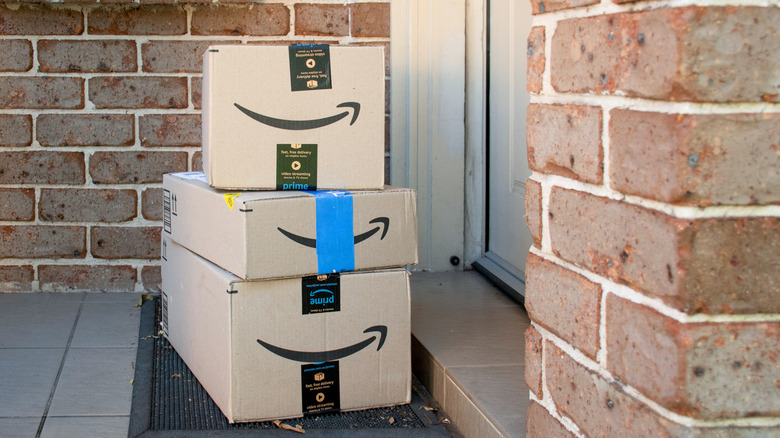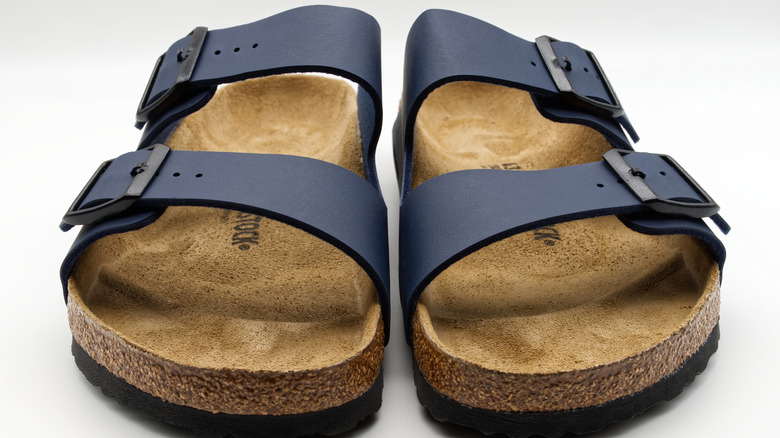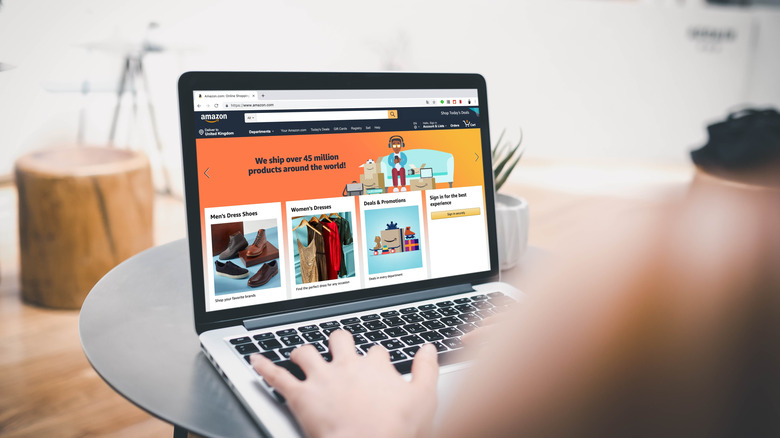You've Been Warned: Buying A Popular Shoe Brand On Amazon Could Cost You
We may receive a commission on purchases made from links.
Amazon can be, and often is, the easiest one-stop shop for everything your household might need. From housewares to cleaning supplies to clothes, Amazon can make it easier than ever to take care of your to-do list without the need to drive all over town to various stores. Perhaps that's why more American consumers are using Amazon than ever before. In fact, a Bloomberg analysis found that U.S. Amazon Prime membership (we broke down if a membership is worth it) numbers hit a record high 180 million consumers in 2024. According to Amazon, U.S. sellers alone sold over 4.5 billion items on Amazon in 2023, which is an average of 8,600 products every minute.
However, while Amazon can certainly be the biggest place to find all of your shopping needs, it isn't necessarily the best. In fact, depending on the specific brands or products you're looking for, it could be worth buying items directly from the brand or company in question rather than shopping for it on Amazon. While some items, like large furniture, are generally better left to in person shopping, there are smaller Amazon purchases you might want to also reconsider. The chances are good that the item will be available on the Amazon Marketplace, but you might not get exactly what you paid for when shopping for certain brands, or products, on Amazon. Between the potential for counterfeit products, to the risk of flat out unsafe ones, let's dive into how the individual sellers on Amazon Marketplace can impact your shopping cart.
Brands no longer on Amazon
Many popular brands have cut ties with Amazon over the years. In 2019 and 2020, in particular, brands like Nike, Ikea, PopSocket, and Birkenstock all severed ties with the retailer. When a brand ends its relationship with Amazon it is essentially removing itself as a first-party seller on the Amazon marketplace. This means that consumers who might shop on Amazon and want to buy that brand will no longer be able to purchase those products directly from the company. However, that doesn't completely stop products from brands like Nike and Birkenstock from being listed on Amazon. Third-party sellers are still able to sell products from those brands, but there can be risks involved in buying from these third-party sellers (especially when it comes to the Nike and Birkenstock brands). More on that later.
As for why other brands decided to end their relationship with Amazon, the reasons vary by company. For instance, IKEA evidently exited its Amazon relationship after Amazon discontinued a smart lighting program with the company. Meanwhile brands like PopSocket struggled to keep up with the aggressive pricing competition that is the norm on Amazon's marketplace. Another consideration is how selling through Amazon can dilute or damage a company's image or even larger price point. More recently, shipping giant UPS announced it would be cutting its business with Amazon by 50%. UPS' Chief Executive Carol Tomé explained the decision, "Amazon is our largest customer, but it's not our most profitable customer. Its margin is very dilutive to the U.S. domestic business."
Third-party vendors
You might be surprised to learn that more than 60% of all sales that occur on Amazon are actually being fulfilled by independent sellers (many of which are small- and medium-sized businesses). While Amazon itself does offer products directly from itself, a vast majority of the products available within the Amazon marketplace are coming from other sellers. This is why not all items are available for Prime shipping, but, more importantly, it's why some items available on Amazon might not exactly be above board. This means that, as a shopper, you could not only be facing higher prices than regular retail for the same pair of shoes but you could be facing counterfeit products.
This ended up being especially true for brands like Birkenstock and Nike (which both dealt with high quantities of counterfeit products available on the Amazon marketplace). Amazon's unwillingness to combat these counterfeit products is largely at the core of why these brands chose to end their relationship with Amazon altogether. A 2019 investigative report from The Wall Street Journal even found that Amazon had thousands of banned, unsafe, or mislabeled products listed within its marketplace. A January 2020 Homeland Security report stated that, "Many consumers are also unaware of the significant probabilities they face of being defrauded by counterfeiters when they shop on e-commerce platforms." It's important to pay close attention to the actual seller you're buying from on Amazon, and to maybe reconsider buying certain products directly from the company that makes them.


